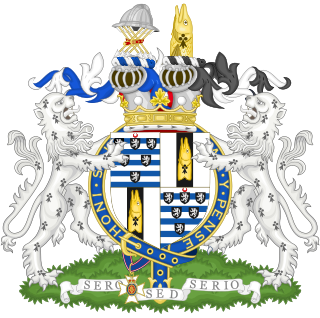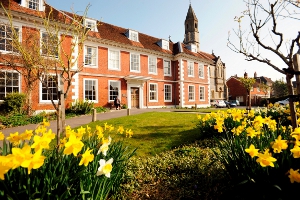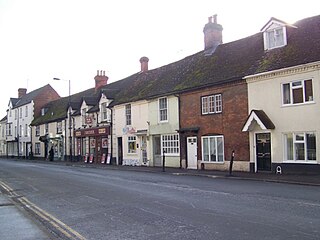
Wiltshire is a ceremonial county in South West England. It borders Gloucestershire to the north, Oxfordshire to the north-east, Berkshire to the east, Hampshire to the south-east, Dorset to the south, and Somerset to the west. The largest settlement is Swindon, and Trowbridge is the county town.

Salisbury is a cathedral city and civil parish in Wiltshire, England with a population of 41,820, at the confluence of the rivers Avon, Nadder and Bourne. The city is approximately 20 miles from Southampton and 30 miles from Bath.

Marquess of Salisbury is a title in the Peerage of Great Britain. It was created in 1789 for the 7th Earl of Salisbury. Most of the holders of the title have been prominent in British political life over the last two centuries, particularly the 3rd Marquess, who served three times as Prime Minister in the late 19th and early 20th centuries.

Phillips Exeter Academy is a co-educational college-preparatory school in Exeter, New Hampshire. Established in 1781, it is America's sixth-oldest boarding school. It educates roughly 1,100 boarding and day students in grades 9 through 12, as well as postgraduate students.

Exmouth is a port town, civil parish and seaside resort situated on the east bank of the mouth of the River Exe, 11 miles (18 km) southeast of Exeter.

Marquess of Exeter is a title that has been created twice, once in the peerage of England and once in the peerage of the United Kingdom. The first creation came in the peerage of England in 1525 for Henry Courtenay, 2nd Earl of Devon. For more information on this creation, which was forfeited in 1538, see Earl of Devon.

Baron Amherst of Hackney, in the County of London, is a title in the Peerage of the United Kingdom. It was created on 26 August 1892 for the former Conservative Member of Parliament William Tyssen-Amherst, with remainder, in default of male issue, to his eldest daughter Mary and her issue male. Tyssen-Amherst had previously represented West Norfolk and South West Norfolk in the House of Commons. He was succeeded according to the special remainder by his daughter Mary. She was the wife of Colonel Lord William Cecil, third son of William Cecil, 3rd Marquess of Exeter. As of 2017 the title is held by their great-great-grandson, the fifth Baron, who succeeded his father in 2009. As a male-line descendant of the third Marquess of Exeter he is also in remainder to this peerage and its subsidiary titles the earldom of Exeter and barony of Burghley.

Richard Hill is a rugby union coach and former English international rugby footballer.
The Percy–Neville feud was a series of skirmishes, raids, and vandalism between two prominent northern English families, the House of Percy and the House of Neville, and their followers, that helped provoke the Wars of the Roses. The original reason for the long dispute is unknown, and the first outbreaks of violence were in the 1450s, prior to the Wars of the Roses. The antagonists would later meet in battle several times during the feud.

The West of England line is a British railway line from Basingstoke, Hampshire, to Exeter St Davids in Devon, England. Passenger services run between London Waterloo station and Exeter; the line intersects with the Wessex Main Line at Salisbury. Despite its historic title, it is not today's principal route from London to the West of England: Exeter and everywhere further west are reached more quickly from London Paddington via the Reading–Taunton line.

Bishop Wordsworth's School is a Church of England boys' grammar school in Salisbury, Wiltshire for boys aged 11 to 18. The school is regularly amongst the top-performing schools in England, and in 2010 was the school with the best results in the English Baccalaureate. It was granted academy status in March 2011 and is an Additional Member of the Headmasters' and Headmistresses' Conference. It is within the grounds of Salisbury Cathedral, adjacent to the Cathedral School.

The Royal School of Church Music (RSCM) is a Christian music education organisation dedicated to the promotion of music in Christian worship, in particular the repertoire and traditions of Anglican church music, largely through publications, training courses and an award scheme. The organisation was founded in England in 1927 by Sir Sydney Nicholson and today it operates internationally, with 8,500 members in over 40 countries worldwide, and is the largest church music organisation in Britain. Its Patron as of May 2024 is King Charles III, following the previous monarch Queen Elizabeth II.

Salisbury railway station serves the cathedral city of Salisbury in Wiltshire, England. It is 83 miles 43 chains (134.4 km) from London Waterloo on the West of England line to Exeter St Davids. This is crossed by the Wessex Main Line from Bristol Temple Meads to Southampton Central. The station is operated and served by South Western Railway (SWR), and is also served by Great Western Railway (GWR).

Wilton is a town and civil parish in Wiltshire, England. Lying about 3 miles (5 km) west of the city of Salisbury, and until 1889 the county town of Wiltshire, it has a rich heritage dating back to the Anglo-Saxons.

Uffculme is a village and civil parish located in the Mid Devon district, of Devon, England. Situated in the Blackdown Hills on the B3440, close to the M5 motorway and the Bristol–Exeter railway line, near Cullompton, Uffculme is on the upper reaches of the River Culm. The population of the parish, according to a 2020 estimate, is 3,090. It is surrounded, clockwise from the north, by the parishes of Culmstock, Hemyock, Sheldon, Kentisbeare, Cullompton, Willand, Halberton and Burlescombe.
This article describes the history and operation of the railway routes west of Salisbury built by the London and South Western Railway (LSWR) and allied companies, which ultimately became part of the Southern Railway in the United Kingdom. Salisbury forms a natural boundary between the Southern Railway core routes in the counties surrounding London, and the long route connecting with the Devon and Cornwall lines.

John Fisher was a Church of England bishop, serving as Bishop of Exeter, then Bishop of Salisbury.

Exeter is a cathedral city and the county town of Devon, South West England. It is situated on the River Exe, approximately 36 mi (58 km) northeast of Plymouth and 65 mi (105 km) southwest of Bristol.

The Honeylands, originally the Honeylands Children's Sanatorium and later the Honeylands Children's Centre was a hospital in Exeter, Devon used as a children's pulmonary tuberculosis sanatorium, later used for treatment of children with learning difficulties. Adults were treated at the nearby Whipton Hospital.

















